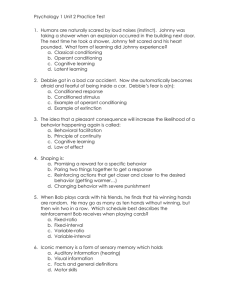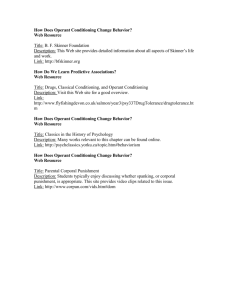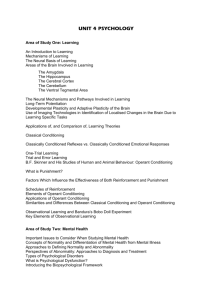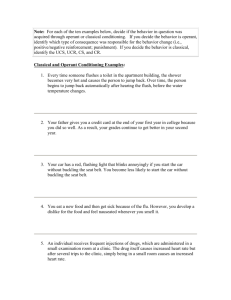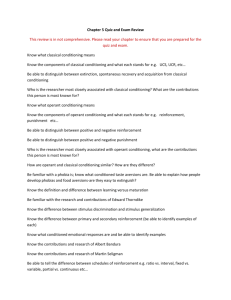File
advertisement
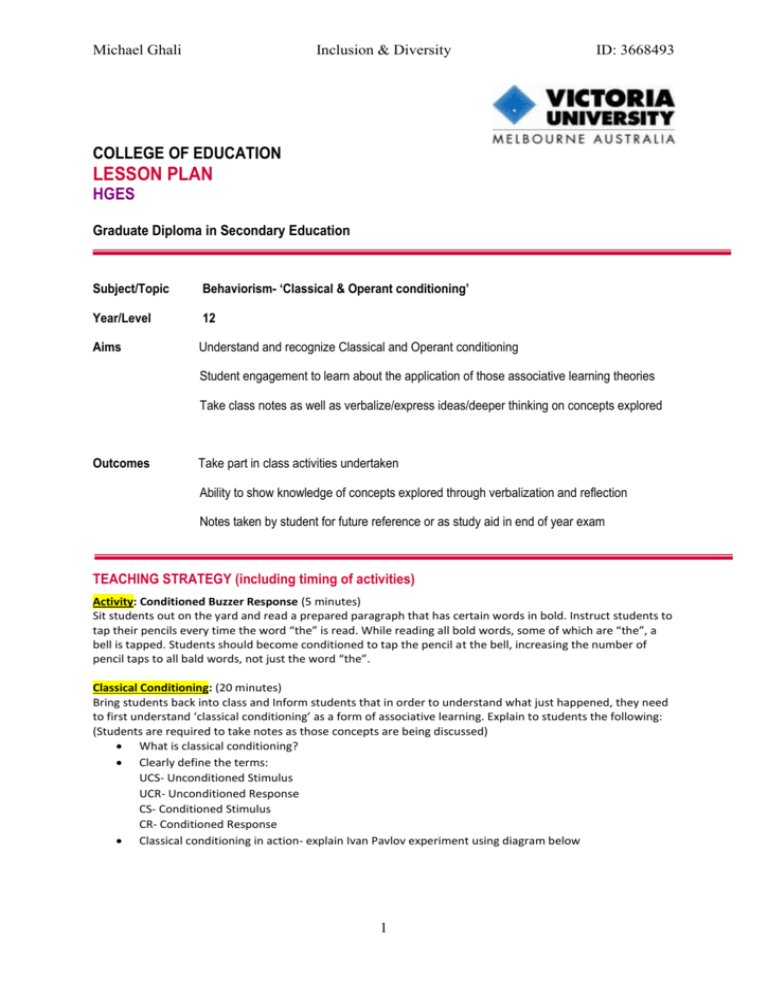
Michael Ghali Inclusion & Diversity ID: 3668493 COLLEGE OF EDUCATION LESSON PLAN HGES Graduate Diploma in Secondary Education Subject/Topic Behaviorism- ‘Classical & Operant conditioning’ Year/Level 12 Aims Understand and recognize Classical and Operant conditioning Student engagement to learn about the application of those associative learning theories Take class notes as well as verbalize/express ideas/deeper thinking on concepts explored Outcomes Take part in class activities undertaken Ability to show knowledge of concepts explored through verbalization and reflection Notes taken by student for future reference or as study aid in end of year exam TEACHING STRATEGY (including timing of activities) Activity: Conditioned Buzzer Response (5 minutes) Sit students out on the yard and read a prepared paragraph that has certain words in bold. Instruct students to tap their pencils every time the word “the” is read. While reading all bold words, some of which are “the”, a bell is tapped. Students should become conditioned to tap the pencil at the bell, increasing the number of pencil taps to all bald words, not just the word “the”. Classical Conditioning: (20 minutes) Bring students back into class and Inform students that in order to understand what just happened, they need to first understand ‘classical conditioning’ as a form of associative learning. Explain to students the following: (Students are required to take notes as those concepts are being discussed) What is classical conditioning? Clearly define the terms: UCS- Unconditioned Stimulus UCR- Unconditioned Response CS- Conditioned Stimulus CR- Conditioned Response Classical conditioning in action- explain Ivan Pavlov experiment using diagram below 1 Michael Ghali Inclusion & Diversity ID: 3668493 Reflecting on what has been mentioned, students should now be able to verbalise that their behaviour was conditioned in the earlier activity and that: UCR (‘the’) when paired with CS (Bell) lead to students becoming conditioned to tap the pencil which was at first an UCR and is now a CR as a result of the bell being associated to the word ‘the’ and now pencil tapping has increased to all bald words, not just the word ‘the’. Activity: ‘Operant conditioning in Action’ (5 minutes) Students are to watch a two minute YouTube video of Sheldon from the show ‘The big bang theory’ as he is seen training penny to behave or be conditioned to act in a certain manner using operant conditioning techniques. http://www.youtube.com/watch?v=Mt4N9GSBoMI Ask students what they believe the video was about to trigger discussion about operant conditioning. Operant Conditioning: (20 minutes) Use the video to continue forming a discussion and guiding students to understand: o What is operant conditioning? o Introduce students to Thorndike & Skinner’s work o o Use of positive and negative reinforcement to shape behaviour Provide three examples to students of operant conditioning: Personal example: advise students that their engagement, happiness, and willingness to work are positive reinforcements to me as a teacher to continue providing appealing and insightful content. Historical example: Nelson Mandela was reinforced for his great attitude and peaceful leadership with a Noble Peace Price in 1993 which motivated him to continue excelling to the man he is remembered by today. (Cross-curriculum) Sport example: A soccer coach may choose not to give a player the opportunity to play in upcoming games if the player has not been training or playing to his best. This negative reinforcement is given to the player in the hope that he will get the message and work harder to get back into team action. (Cross-Curriculum) Activity: (10 minutes): Ask students to now sit in pairs for the next five minutes and share with each other a personal, historical and sport related examples that highlight operant conditioning and the use of reinforcement to shape behaviour. Use the last five minutes of class to go around and hear as a class operant conditioning examples verbalised by members of the class and conclude with checking that class notes have been taken. 2 Michael Ghali Inclusion & Diversity ID: 3668493 Assessment Students will be assessed on their ability to engage in activities given and show ability to verbalise as well as reflect on concepts being explored Students will also be required to show maturity and team work when discussing operant examples and ideas in together in pairs and in front of the class. Student class notes are checked by teacher at the end of class. Post-lesson Reflection Areas for Improvement Mentor Feedback 3

